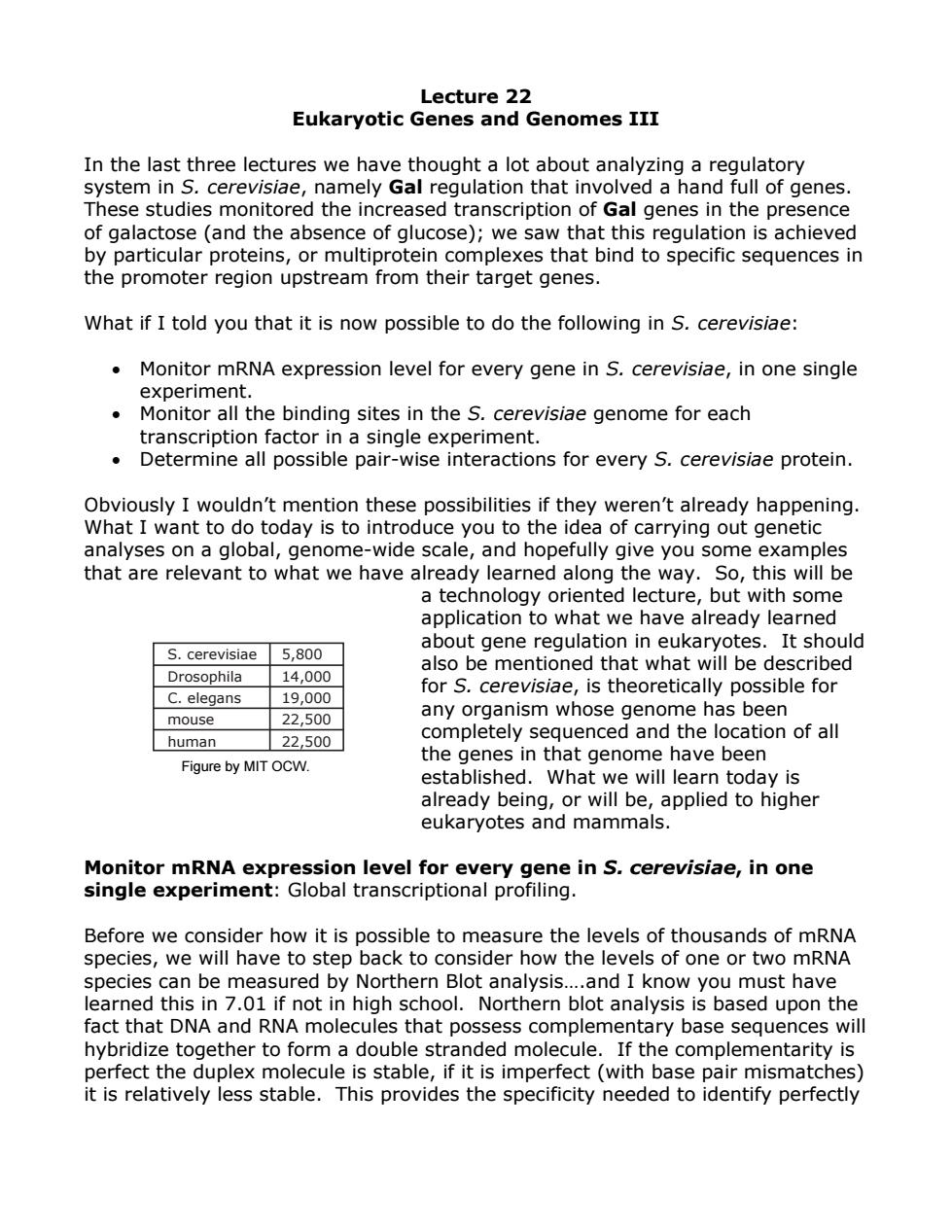正在加载图片...

Lecture 22 Eukaryotic Genes and Genomes III In the last three lectures we have thought a lot about analyzing a regulatory system in S.cerevisiae,namely Gal regulation that involved a hand full of genes. These studies monitored the increased transcription of Gal genes in the presence of galactose (and the absence of glucose);we saw that this regulation is achieved by particular proteins,or multiprotein complexes that bind to specific sequences in the promoter region upstream from their target genes. What if I told you that it is now possible to do the following in S.cerevisiae: Monitor mRNA expression level for every gene in S.cerevisiae,in one single experiment. Monitor all the binding sites in the S.cerevisiae genome for each transcription factor in a single experiment. Determine all possible pair-wise interactions for every S.cerevisiae protein. Obviously I wouldn't mention these possibilities if they weren't already happening. What I want to do today is to introduce you to the idea of carrying out genetic analyses on a global,genome-wide scale,and hopefully give you some examples that are relevant to what we have already learned along the way.So,this will be a technology oriented lecture,but with some application to what we have already learned about gene regulation in eukaryotes.It should S.cerevisiae 5,800 also be mentioned that what will be described Drosophila 14,000 for S.cerevisiae,is theoretically possible for C.elegans 19,000 mouse 22,500 any organism whose genome has been human 22,500 completely sequenced and the location of all Figure by MIT OCW. the genes in that genome have been established.What we will learn today is already being,or will be,applied to higher eukaryotes and mammals. Monitor mRNA expression level for every gene in S.cerevisiae,in one single experiment:Global transcriptional profiling. Before we consider how it is possible to measure the levels of thousands of mRNA species,we will have to step back to consider how the levels of one or two mRNA species can be measured by Northern Blot analysis....and I know you must have learned this in 7.01 if not in high school.Northern blot analysis is based upon the fact that DNA and RNA molecules that possess complementary base sequences will hybridize together to form a double stranded molecule.If the complementarity is perfect the duplex molecule is stable,if it is imperfect(with base pair mismatches) it is relatively less stable.This provides the specificity needed to identify perfectlyLecture 22 Eukaryotic Genes and Genomes III In the last three lectures we have thought a lot about analyzing a regulatory system in S. cerevisiae, namely Gal regulation that involved a hand full of genes. These studies monitored the increased transcription of Gal genes in the presence of galactose (and the absence of glucose); we saw that this regulation is achieved by particular proteins, or multiprotein complexes that bind to specific sequences in the promoter region upstream from their target genes. What if I told you that it is now possible to do the following in S. cerevisiae: • Monitor mRNA expression level for every gene in S. cerevisiae, in one single experiment. • Monitor all the binding sites in the S. cerevisiae genome for each transcription factor in a single experiment. • Determine all possible pair-wise interactions for every S. cerevisiae protein. Obviously I wouldn’t mention these possibilities if they weren’t already happening. What I want to do today is to introduce you to the idea of carrying out genetic analyses on a global, genome-wide scale, and hopefully give you some examples that are relevant to what we have already learned along the way. So, this will be a technology oriented lecture, but with some application to what we have already learned about gene regulation in eukaryotes. It should also be mentioned that what will be described for S. cerevisiae, is theoretically possible for any organism whose genome has been completely sequenced and the location of all the genes in that genome have been established. What we will learn today is already being, or will be, applied to higher eukaryotes and mammals. Monitor mRNA expression level for every gene in S. cerevisiae, in one single experiment: Global transcriptional profiling. Before we consider how it is possible to measure the levels of thousands of mRNA species, we will have to step back to consider how the levels of one or two mRNA species can be measured by Northern Blot analysis….and I know you must have learned this in 7.01 if not in high school. Northern blot analysis is based upon the fact that DNA and RNA molecules that possess complementary base sequences will hybridize together to form a double stranded molecule. If the complementarity is perfect the duplex molecule is stable, if it is imperfect (with base pair mismatches) it is relatively less stable. This provides the specificity needed to identify perfectly S. cerevisiae Drosophila C. elegans mouse human 5,800 14,000 19,000 22,500 22,500 Figure by MIT OCW